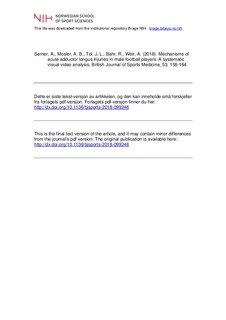| dc.contributor.author | Serner, Andreas | |
| dc.contributor.author | Mosler, Andrea Britt | |
| dc.contributor.author | Tol, Johannes L. | |
| dc.contributor.author | Bahr, Roald | |
| dc.contributor.author | Weir, Adam | |
| dc.date.accessioned | 2019-05-15T14:35:00Z | |
| dc.date.available | 2019-05-15T14:35:00Z | |
| dc.date.created | 2018-10-11T12:24:32Z | |
| dc.date.issued | 2018 | |
| dc.identifier.citation | British Journal of Sports Medicine. 2018, 0, 1-8. | nb_NO |
| dc.identifier.issn | 0306-3674 | |
| dc.identifier.uri | http://hdl.handle.net/11250/2597730 | |
| dc.description | I Brage finner du siste tekst-versjon av artikkelen, og den kan inneholde ubetydelige forskjeller fra forlagets pdf-versjon. Forlagets pdf-versjon finner du på bmj.com / In Brage you'll find the final text version of the article, and it may contain insignificant differences from the journal's pdf version. The definitive version is available at bmj.com | nb_NO |
| dc.description.abstract | Background: Change of direction and kicking have been described as the main actions resulting in adductor longus injury. Video descriptions of inciting events are lacking. Objective: Perform a standardised visual video analysis of a series of acute adductor longus injuries in football. Study design: Cross-sectional. Methods: Video footage was reviewed by players, and assessed independently by five sports medicine professionals. Inciting events were described and categorised using standardised scoring, including playing situation, player/opponent behaviour, movement and body positions. Results: Videos of acute adductor longus injuries in 17 professional male football players were analysed. Most injuries occurred in non-contact situations (71%), following a quick reaction to a change in play (53%). Injury actions were: change of direction (35%), kicking (29%), reaching (24%) and jumping (12%). Change of direction and reaching injuries were categorised as closed chain movements (59%), characterised by hip extension and abduction with external rotation. Kicking and jumping injuries were categorised as open chain (41%), characterised by a change from hip extension to hip flexion, and hip abduction to adduction, with external rotation. Conclusion: Acute adductor longus injuries in football occur in a variety of situations. Player actions can be categorised into closed (change of direction and reaching) and open (kicking and jumping) chain movements involving triplanar hip motion. A rapid muscle activation during a rapid muscle lengthening appears to be the fundamental injury mechanism for acute adductor longus injuries. | nb_NO |
| dc.language.iso | eng | nb_NO |
| dc.subject | groin | nb_NO |
| dc.subject | soccer | nb_NO |
| dc.subject | muscle injury | nb_NO |
| dc.subject | strain | nb_NO |
| dc.subject | avulsion | nb_NO |
| dc.subject | musculotendinous junction | nb_NO |
| dc.title | Mechanisms of acute adductor longus injuries in male football players: A systematic visual video analysis | nb_NO |
| dc.type | Journal article | nb_NO |
| dc.type | Peer reviewed | nb_NO |
| dc.description.version | acceptedVersion | nb_NO |
| dc.source.pagenumber | 8 | nb_NO |
| dc.source.journal | British Journal of Sports Medicine | nb_NO |
| dc.identifier.doi | 10.1136/bjsports-2018-099246 | |
| dc.identifier.cristin | 1619636 | |
| dc.description.localcode | Seksjon for idrettsmedisinske fag / Department of Sports Medicine | nb_NO |
| cristin.unitcode | 150,34,0,0 | |
| cristin.unitname | Seksjon for idrettsmedisinske fag | |
| cristin.ispublished | true | |
| cristin.fulltext | postprint | |
| cristin.qualitycode | 2 | |
